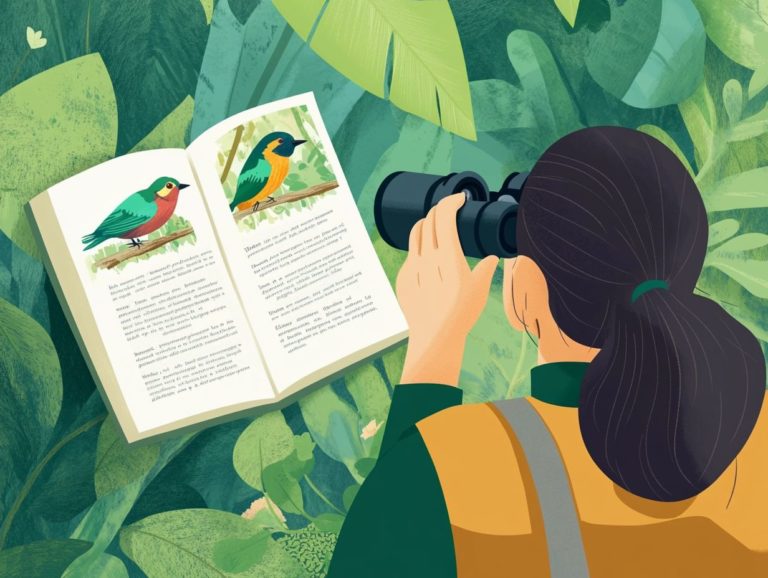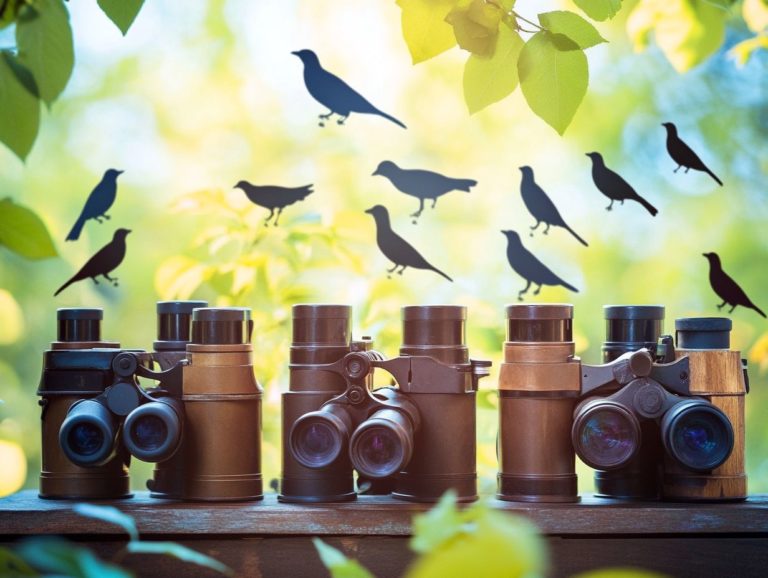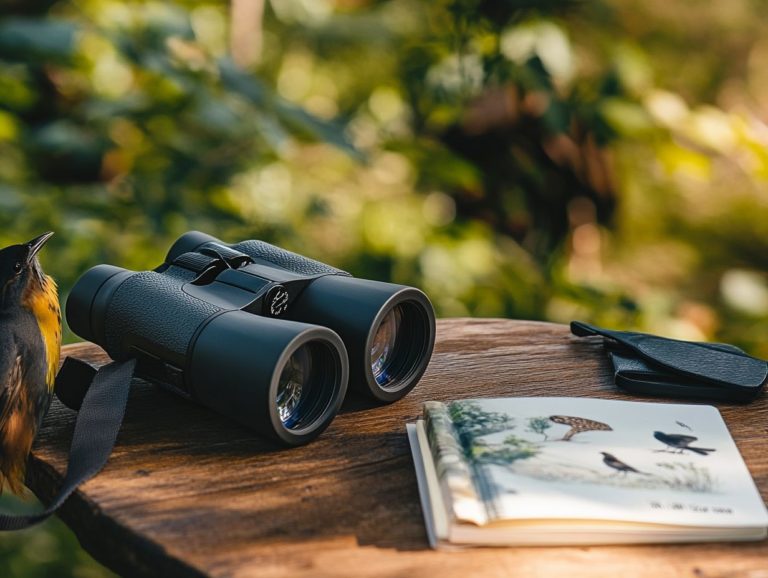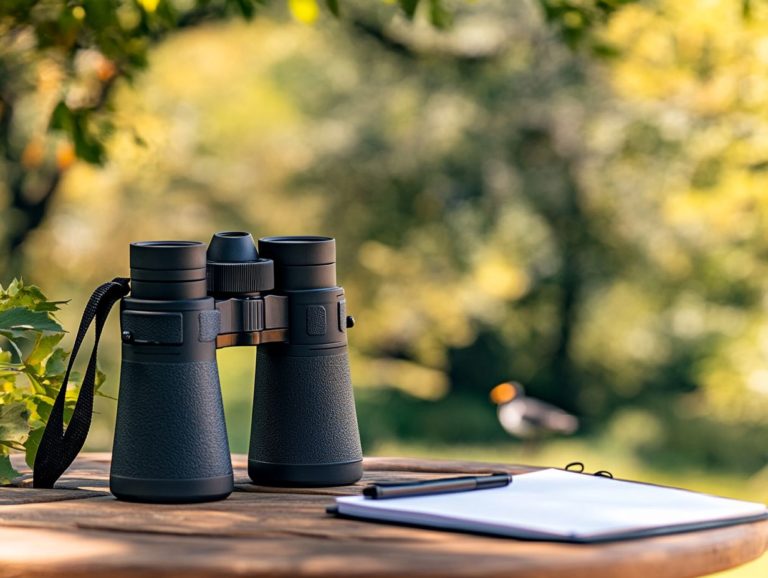Understanding Binocular Specifications for Birders
When it comes to birdwatching, the right pair of binoculars can transform your experience into something extraordinary.
With countless options at your fingertips, grasping the specifications is essential. This guide demystifies key factors such as magnification, objective lens size, and field of view. It helps you navigate the often-daunting technical jargon with ease.
Whether you’re a seasoned enthusiast or just beginning your journey, this resource will arm you with the insights needed to select the ideal binoculars for your next adventure.
Contents
- Key Takeaways:
- Key Binocular Specifications for Birding
- Interpreting Binocular Specifications
- Frequently Asked Questions
- What are the most important binocular specifications for birders?
- What is the ideal magnification for birding binoculars?
- How does objective lens diameter affect birding binoculars?
- What is field of view and why is it important for birding?
- Why is close focus distance a crucial specification for birding binoculars?
- How does the exit pupil affect the performance of birding binoculars?
Key Takeaways:
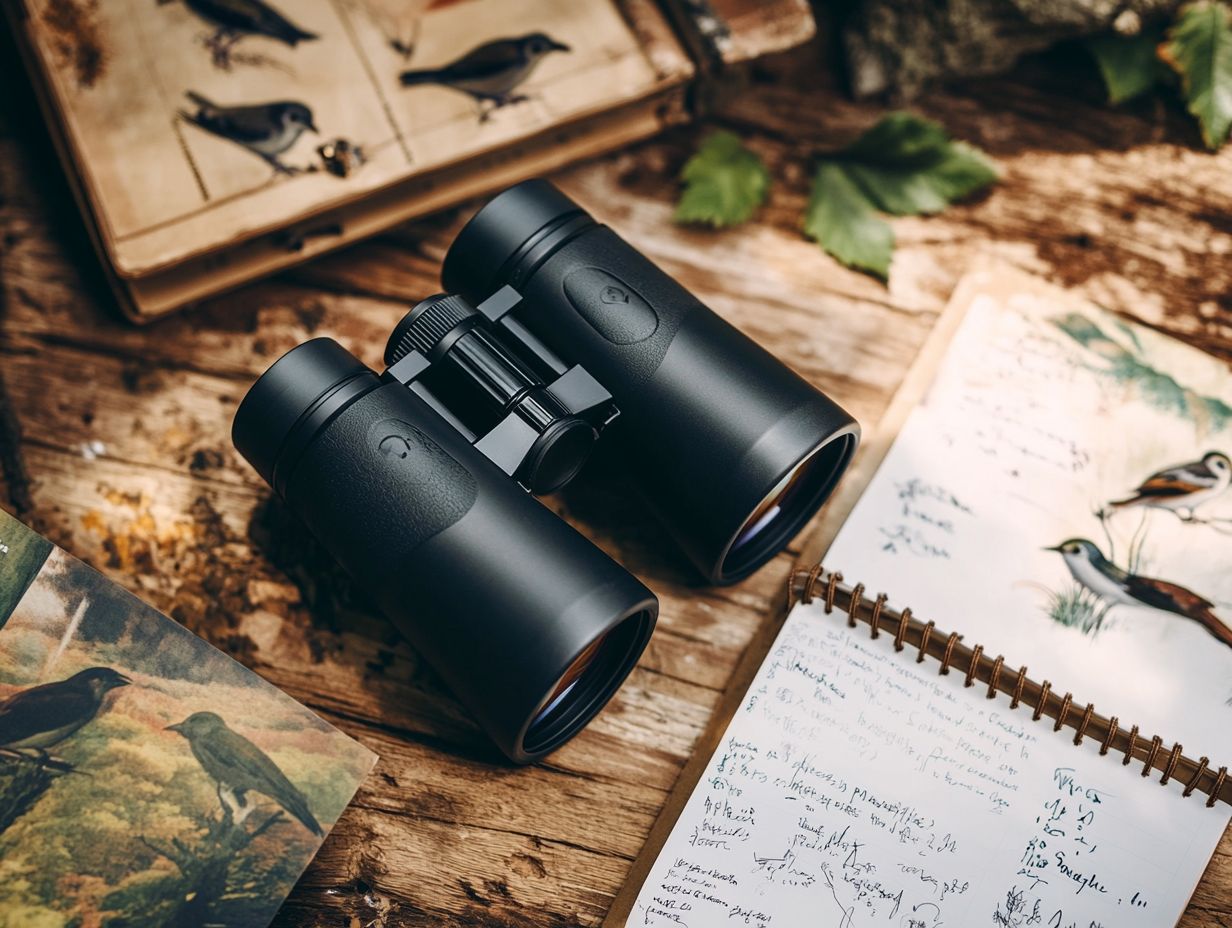
- Pay attention to magnification and objective lens size they determine the power and clarity of your binoculars.
- A wider field of view and close focus enhance your birding experience, allowing you to see more details in nature.
- Consider exit pupil (the size of the image at the eyepiece) and eye relief (the distance your eye can be from the lens) for comfortable viewing.
Why Understanding Specifications is Important for Birders
Understanding specifications is essential for birders as it directly impacts your ability to use binoculars effectively for bird identification.
Whether you re a seasoned pro or just starting out, having the right binoculars tailored to your birding needs can transform your outdoor adventures.
From magnification power to field of view, these specifications ensure you’re equipped to catch those fleeting glimpses of elusive birds. Understanding the importance of binoculars in birding makes every birdwatching trip truly rewarding.
A higher magnification power offers you closer views of distant species, heightening the excitement of spotting rare birds. However, it s not just about getting up close.
A wide field of view lets you observe more of the area, allowing you to track moving subjects without losing sight of them.
Grab these top tips for birdwatching: considering lighting and terrain helps you maximize the effectiveness of these specifications.
Selecting binoculars from reputable brands recognized within the birding community can also elevate your experience. They craft products with features designed to meet the needs of both novice and veteran birders alike.
Key Binocular Specifications for Birding
When you’re choosing binoculars, grasping the essential specifications is crucial, especially if you’re a birdwatching enthusiast.
The right blend of magnification power and objective lens size can greatly enhance your ability to observe birds in diverse settings, whether you’re at the Audubon Center or meandering along a nature trail.
Top considerations like field of view and close focus distance are essential. They allow you to swiftly spot and focus on birds, ultimately elevating your birdwatching experience to new heights.
Magnification and Objective Lens Size
Magnification and objective lens size are critical specifications to consider when choosing birding binoculars, as they directly influence your ability to observe birds in their natural habitats. For those interested in a more detailed view, understanding spotting scope specifications is also essential.
Opting for binoculars with a magnification power of 8×42 or 10×50 allows you to experience different levels of detail and brightness, enabling you to select what best meets your needs.
While higher magnifications can enhance detail, they often result in a narrower field of view. This makes it crucial to strike a balance that suits your specific birding conditions.
Understanding how these factors interact can significantly enrich your birdwatching experience. For example, in low-light settings such as early mornings or dense forests, larger objective lenses excel at gathering light, producing brighter images a vital consideration when attempting to spot elusive species.
On the flip side, while high magnification may appear beneficial for detail, it can lead to image shake. This complicates your ability to track fast-moving birds, especially at elevated power settings.
Thus, a moderate magnification combined with an appropriately sized lens often yields the best results. This ensures versatility across varying lighting conditions and enhances your overall enjoyment of birding.
Field of View and Close Focus
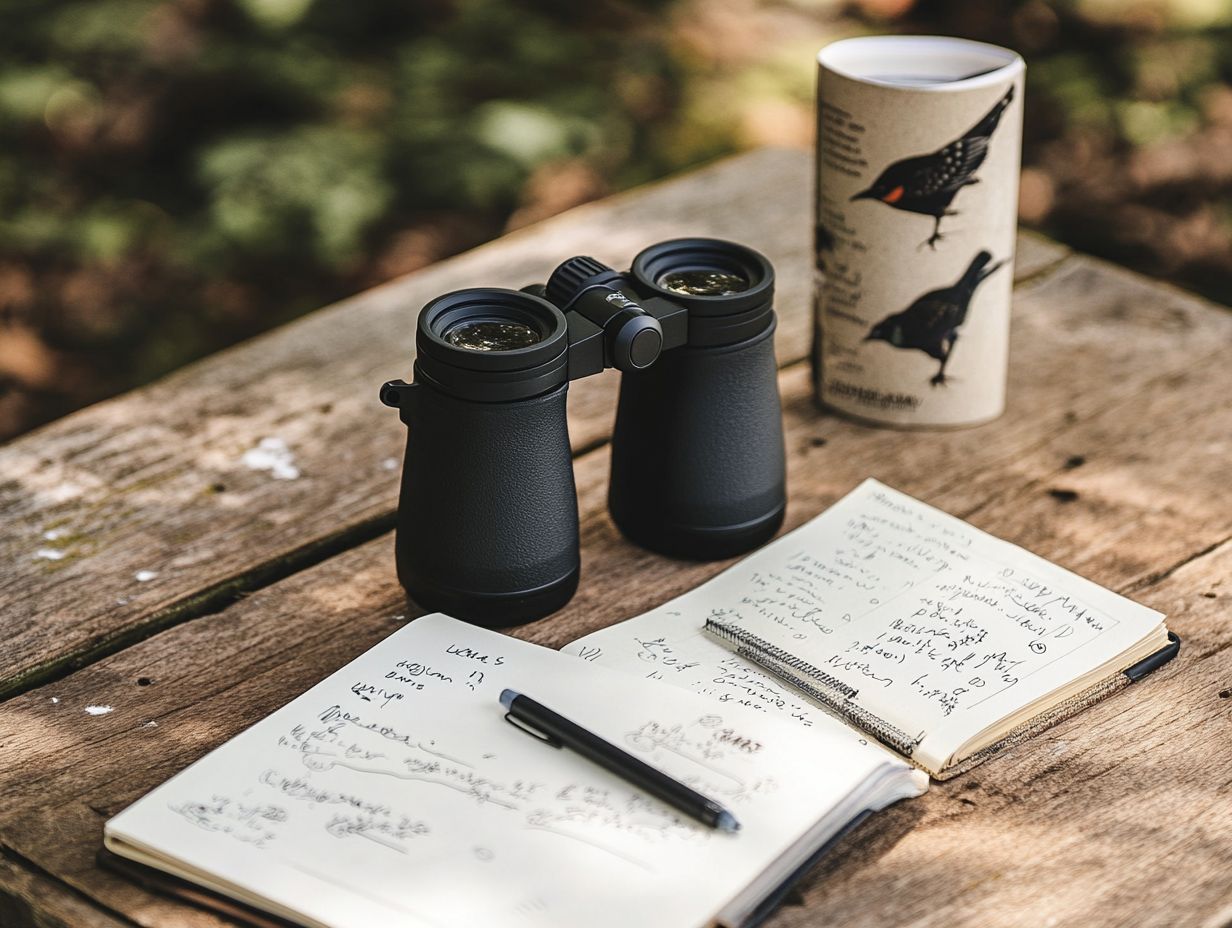
Field of view and close focus distance are essential for spotting birds effectively. A wide field of view helps you track fast-moving birds.
Strong close focus allows you to admire details when birds are nearby. Balancing these features with enough eye relief keeps you comfortable during long birdwatching sessions.
Imagine watching an American Robin flitting through the underbrush. A wider field of view makes tracking its movements effortless and helps you avoid missed opportunities.
When you spot a perched Ruby-throated Hummingbird just a few feet away, excellent close focus becomes invaluable for soaking in the iridescence of its feathers.
These characteristics play a crucial role in choosing binoculars or spotting scopes. Size and weight should also be part of your considerations. Understanding and leveraging these aspects can significantly enhance your birdwatching experience.
Exit Pupil and Eye Relief
Exit pupil and eye relief are often overlooked specifications that greatly affect your binocular experience, especially in low-light conditions typical of dawn and dusk. The exit pupil refers to the size of the circle of light entering your eyes, while adequate eye relief is crucial for comfort particularly if you wear glasses.
These features ensure bright, clear images and minimize strain during extended use.
In dim lighting, a larger exit pupil allows more light to reach your eyes, resulting in brighter images that can make a significant difference when you’re spotting wildlife or celestial events. Comfortable eye relief keeps discomfort at bay, allowing you to maintain a proper viewing position without squinting.
This combination enhances visual performance in challenging lighting and encourages longer observation sessions without fatigue. These specifications are essential for both casual observers and serious enthusiasts alike.
Prism Type and Coatings
The choice of prism type and the quality of coatings on binocular lenses greatly impact image brightness and clarity for birdwatchers. For those passionate about avian observation, understanding these differences can elevate the overall experience.
Porro prisms, though bulkier, deliver depth perception and a three-dimensional view deemed essential for tracking swift-moving creatures. Conversely, roof prisms, celebrated for their sleek design, provide portability without compromising visual quality.
Opt for premium coatings like fully multi-coated optics; these reduce glare and enhance contrast. You won t miss those fine details of plumage and subtle color variations, even in challenging natural light. Paying attention to optical technology gives birdwatchers a notable edge during their expeditions.
Interpreting Binocular Specifications
Interpreting binocular specifications requires a thorough understanding of how each component influences overall performance, especially for birdwatchers. Seasoned birders recognize the transformative power of the right binoculars, and understanding binocular terminology for birders enhances their outdoor adventures, allowing them to spot birds with remarkable clarity and ease.
As you navigate your purchasing decision, consider how factors like price, quality, and features tailored to your unique birding needs become essential for elevating your birdwatching experience!
How to Compare and Choose the Right Binoculars
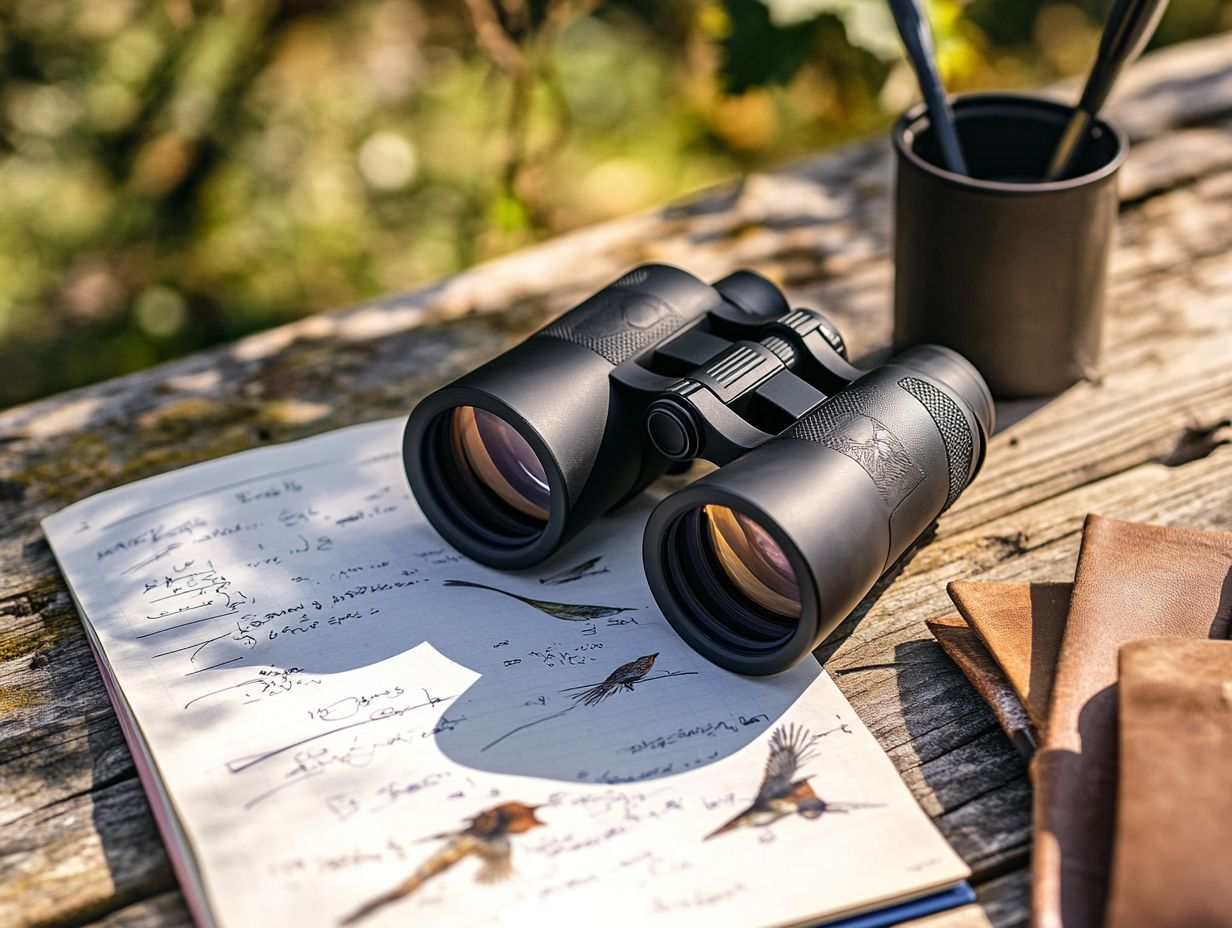
When you’re in the market for birding binoculars, finding the right pair can transform your birdwatching adventures! It’s essential to compare different models based on their specifications and features, so be sure to consider what makes a great pair of bird watching binoculars to find the perfect fit for your needs.
You might want to explore specific aspects like lens quality, which significantly impacts light transmission and clarity. Look for features such as waterproofing and fog-proofing to ensure your binoculars can handle various weather conditions.
Consider the weight and ergonomics of the binoculars as well. Comfort is key during those long viewing sessions in the field.
Taking the time to evaluate user reviews and expert comparisons can offer valuable insights into how different models perform in real-world scenarios. Ultimately, balancing these criteria will guide you to a pair that enhances your birdwatching experience.
Frequently Asked Questions
What are the most important binocular specifications for birders?
The most important binocular specifications for birders include magnification, objective lens diameter, field of view, close focus distance, and exit pupil. These factors affect clarity, brightness, and ease of use for high-quality binoculars while birding, especially for seasoned birders.
What is the ideal magnification for birding binoculars?
For birdwatching, go for binoculars with 8x to 10x magnification. This range gives you the best view without losing sight of your surroundings.
How does objective lens diameter affect birding binoculars?
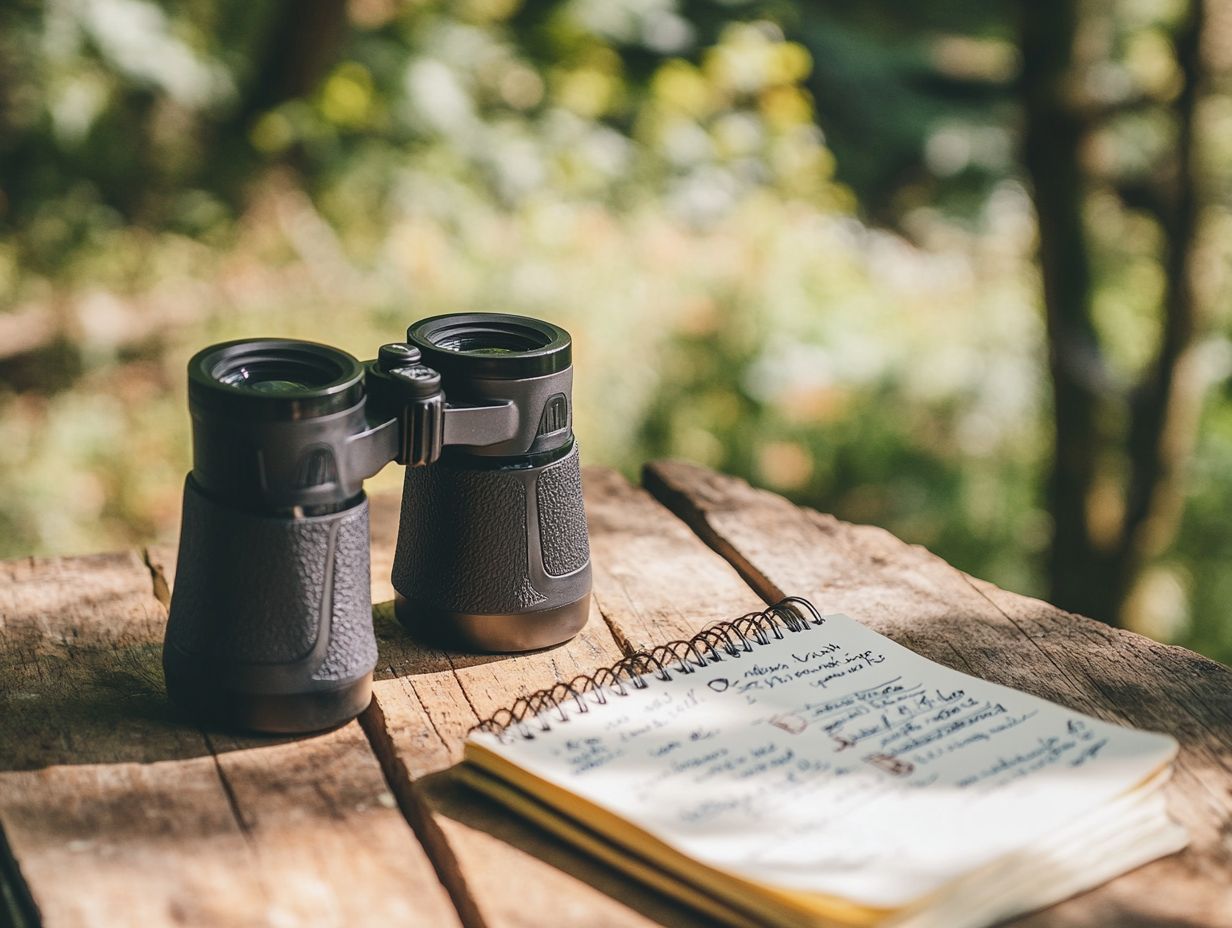
The objective lens diameter determines the amount of light that enters the binoculars. For birders, a larger diameter (around 42mm) is recommended as it allows for more light and brighter images in low-light conditions. This results in a clearer view that enhances your birdwatching experience.
What is field of view and why is it important for birding?
Field of view refers to the width of the area visible through the binoculars. It can vary based on size and model. A wider field of view makes it easier to locate and track birds in their natural habitats, which is crucial for effective birdwatching.
Why is close focus distance a crucial specification for birding binoculars?
Close focus distance is the minimum distance at which the binoculars can focus on an object. For birders, a shorter close focus distance is beneficial as it allows for clear and detailed views of nearby birds, enhancing overall comfort.
How does the exit pupil affect the performance of birding binoculars?
The exit pupil is the amount of light that comes out of the binoculars, affecting how bright the image looks. For birding, a larger exit pupil (around 5mm) is recommended, allowing for brighter and clearer images, especially in low-light conditions. This is essential for optimal binocular performance.
Ready to find your perfect pair of binoculars? Start exploring your options today!

